Effects of wearing N95 and surgical facemasks on heart rate, thermal stress and subjective sensations
- PMID: 15918037
- PMCID: PMC7087880
- DOI: 10.1007/s00420-004-0584-4
Effects of wearing N95 and surgical facemasks on heart rate, thermal stress and subjective sensations
Abstract
Aim: The study was aimed at investigating the effects of wearing N95 and surgical facemasks with and without nano-functional treatments on thermophysiological responses and the subjective perception of discomfort.
Method: Five healthy male and five healthy female participants performed intermittent exercise on a treadmill while wearing the protective facemasks in a climate chamber controlled at an air temperature of 25 degrees C and a relative humidity of 70%. Four types of facemasks, including N95 (3M 8210) and surgical facemasks, which were treated with nano-functional materials, were used in the study.
Results: (1) The subjects had significantly lower average heart rates when wearing nano-treated and untreated surgical facemasks than when wearing nano-treated and untreated N95 facemasks. (2) The outer surface temperature of both surgical facemasks was significantly higher than that of both N95 facemasks. On the other hand, the microclimate and skin temperatures inside the facemask were significantly lower than those in both N95 facemasks. (3) Both surgical facemasks had significantly higher absolute humidity outside the surface than both N95 facemasks. The absolute humidity inside the surgical facemask was significantly lower than that inside both N95 facemasks. (4) Both surgical facemasks were rated significantly lower for perception of humidity, heat, breath resistance and overall discomfort than both N95 facemasks. The ratings for other sensations, including feeling unfit, tight, itchy, fatigued, odorous and salty, that were obtained while the subjects were wearing the surgical facemasks were significantly lower than when the subjects were wearing the N95 facemasks. (5) Subjective preference for the nano-treated surgical facemasks was the highest. There was significant differences in preference between the nano-treated and untreated surgical facemasks and between the surgical and N95 facemasks.
Discussion: We discuss how N95 and surgical facemasks induce significantly different temperature and humidity in the microclimates of the facemasks, which have profound influences on heart rate and thermal stress and subjective perception of discomfort.
Figures

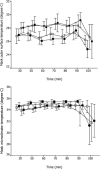
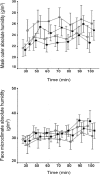
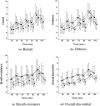
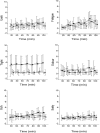
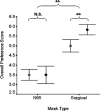
References
-
- Ganong WF. Review of Medical Physiology. Stamford: Appleton and Lange; 1997. pp. 565–566.
-
- Hayashi C, Tokura H. The effects of two kinds of masks (with/without exhaust valve) on clothing microclimates inside the mask in participants wearing protective clothing for spraying pesticides. Int Arch Occup Environ Health. 2004;77:73–78. - PubMed
-
- Li Y, Chung JWY, Wong TKS, Newton N, Hu JY, Guang YT, Guo YP, Yao L, Song QW (2004) In-vivo protective performance of facemasks coated with nano-functional materials. Hong Kong SARS Forum and Hospital Authority Convention, 8–11 May, Hong Kong, 118 pp
-
- Meyer JP, Héry M, Herrault J, Hubert G, François D, Hecht G, Villa M. Field study of subjective assessment of negative pressure half-masks. Influence of the work conditions on comfort and efficiency. Appl Ergon. 1997;28:331–338. - PubMed
Publication types
MeSH terms
LinkOut - more resources
Full Text Sources
Other Literature Sources
Medical

